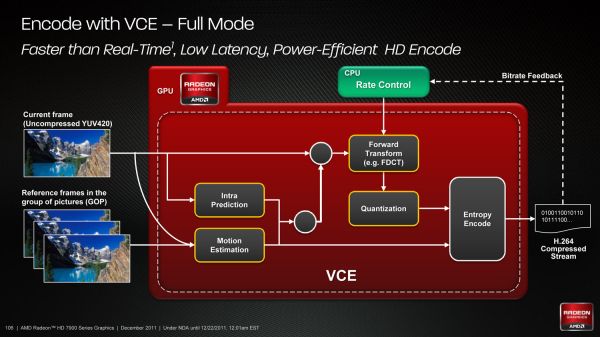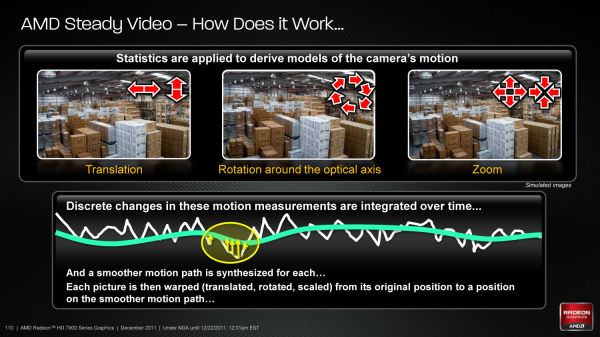AMD Radeon HD 7970 Review: 28nm And Graphics Core Next, Together As One
by Ryan Smith on December 22, 2011 12:00 AM EST- Posted in
- GPUs
- AMD
- Radeon
- ATI
- Radeon HD 7000
Video & Movies: The Video Codec Engine, UVD3, & Steady Video 2.0
When Intel introduced the Sandy Bridge architecture one of their big additions was Quick Sync, their name for their hardware H.264 encoder. By combining a specialized fixed function encoder with some GPU-based processing Intel was able to create a small, highly efficient H.264 encoder that had quality that was as good as or better than AMD and NVIDIA’s GPU based encoders that at the same time was 2x to 4x faster and consumed a fraction of the power. Quick Sync made real-time H.264 encoding practical on even low-power devices, and made GPU encoding redundant at the time. AMD of course isn’t one to sit idle, and they have been hard at work at their own implementation of that technology: the Video Codec Engine (VCE).
The introduction of VCE brings up a very interesting point for discussing the organization of AMD. As both a CPU and a GPU company the line between the two divisions and their technologies often blurs, and Fusion has practically made this mandatory. When AMD wants to implement a feature, is it a GPU feature, a CPU feature, or perhaps it’s both? Intel implemented Quick Sync as a CPU company, but does that mean hardware H.264 encoders are a CPU feature? AMD says no. Hardware H.264 encoders are a GPU feature.
As such VCE is being added to the mix from the GPU side, meaning it shows up first here on the Southern Islands series. Fundamentally VCE is very similar to Quick Sync – it’s based on what you can accomplish with the addition of a fixed function encoder – but AMD takes the concept much further to take full advantage of what the compute side of GCN can do. In “Full Mode” VCE behaves exactly like Quick Sync, in which virtually every step of the H.264 encoding process is handled by fixed function hardware. Just like Quick Sync Full Mode is fast and energy efficient. But it doesn’t make significant use of the rest of the GPU.
Hybrid Mode is where AMD takes things a step further, by throwing the compute resources of the GPU back into the mix. In Hybrid Mode only Entropy Encode is handled by fixed function hardware (this being a highly serial process that was ill suited to a GPU) with all the other steps being handled by the flexible hardware of the GPU. The end goal of Hybrid Mode is that as these other steps are well suited to being done on a GPU, Hybrid Mode will be much faster than even the highly optimized fixed function hardware of Full Mode. Full Mode is already faster than real time – Hybrid Mode should be faster yet.
With VCE AMD is also targeting Quick Sync’s weaknesses regardless of the mode used. Quick Sync has limited tuning capabilities which impacts the quality of the resulting encode. AMD is going to offer more tuning capabilities to allow for a wider range of compression quality. We don’t expect that it will be up to the quality standards of X264 and other pure-software encoders that can generate archival quality encodes, but if AMD is right it should be closer to archival quality than Quick Sync was.
The catch right now is that VCE is so new that we can’t test it. The hardware is there and we’re told it works, but the software support for it is lacking as none of AMD’s partners have added support for it yet. On the positive side this means we’ll be able to test it in-depth once the software is ready as opposed to quickly testing it in time for this review, however the downside is that we cannot comment on the speed or quality at this time. Though with the 7970 not launching until next year, there’s time for software support to be worked out before the first Southern Islands card ever goes on sale.
Moving on, while encoding has been significantly overhauled decoding will remain largely the same. AMD doesn’t refer to the Universal Video Decoder on Tahiti as UVD3, but the specifications match UVD3 as we’ve seen on Cayman so we believe it to be the same decoder. The quality may have been slightly improved as AMD is telling us they’ve scored 200 on HQV 2.0 – the last time we scored them they were at 197 – but HQV is a partially subjective benchmark.
Finally, with Southern Islands AMD is introducing Steady Video 2.0, thesuccessor to Steady Video that was introduced with the Llano APU last year. Steady Video 2.0 adds support for interlaced and letter/pillar boxed content, along with a general increase in the effectiveness of the steadying effect. What makes this particularly interesting is that Steady Video implements a new GCN architecture instruction, Quad Sum of Absolute Differences (QSAD), which combines regular SAD operations with alignment operations into a single instruction. As a result AMD can now execute SADs at a much higher rate so long as they can be organized into QSADs, which is one of the principle reasons that AMD was able to improve Steady Video as it’s a SAD-heavy operation. QSAD extends to more than just Steady Video (AMD noted that it’s also good for other image analysis operations), but Steady Video is going to be the premiere use for it.












292 Comments
View All Comments
Ananke - Thursday, December 22, 2011 - link
"The 7970 leads the 5870 by 50-60% here and in a number of other games"...and as I see it also carries 500-600% of price premium over the 5870.Meh, this is so so priced for a FireGL card, but very badly placed for a consumer market. Regardless, CUDA is getting more open meanwhile. AMD is still several generations/years behind in the HPC market and marketing a product above the NVidia price targets will not help AMD to make it popular.
Having say so, I am using ATI cards for gaming for several years already, and I am very pleased with their IQ and performance. I have always pre-purchased my ATI cards... What I am missing though is teh promised and never materialized consumer level software that can utilize its calculation ability, aka CyberLink and other video transcoders. If it was not for the naughty Nvidia power draw in the 5th series, I would've gone green to have CUDA. Hence, considering SO MUCH MONEY, I am waiting at least 6 months from now to see what the prices will be for the both new contenders in next GPU architectures :).
Dangerous_Dave - Thursday, December 22, 2011 - link
Seems like AMD can't do anything right these days. Bulldozer was designed for a world that doesn't exist, and now we have this new GPU stinking up the place. I'm sorry but @28nm you have double the transistors per area compared with @40nm, yet the performance is only 30% better for a chip that is virtually the same size! It should be at least twice as far ahead of the 6970 as that, even on immature drivers. As it stands, AMD @ 28nm is only just ahead of Nvidia @ 40nm as far as minimums go (the only thing that matters).I shudder to think how badly AMD is going to get destroyed when Nvidia release their 28nm GPU.
Finally - Friday, December 23, 2011 - link
I shudder to think how badly one Nvidia fanboy's ego is going to get scratched if team red released a better GPU and his favourite team has nothing to offer.Oh... they did?
CeriseCogburn - Thursday, March 8, 2012 - link
We have to let amd "go first" now since they have been so on the brink of bankruptcy collapse for so long that they've had to sell off most of their assets... and refinance by AbuDhabi oil money...I think it's nice our laws and global economy puts pressure on the big winners to not utterly crush the underdogs...
Really, if amd makes another fail it might be the last one before collapse and "restructuring" and frankly not many of us want to see that...
They already made the "last move" a dying company does and slashed with the ax at their people...
If the amd fans didn't constantly demand they be given a few dollars off all the time, amd might not be failing - I mean think about it - a near constant loss, because the excessive demand for price vs perf vs the enemy is all the radeon fans claim to care about.
It would be better for us all if the radeon fans dropped the constant $ complaints and just manned up and supported AMD as real fans, with their pocketbooks... instead of driving their favorite toward bankruptcy and cooked books filled with red ink...
Dangerous_Dave - Thursday, December 22, 2011 - link
On reflection this card is even worse than my initial analysis. For 3.4billion transistors AMD could have done no research at all and simply integrated two 6870s onto a single die (a la 5870 vs 4870) and ramped up the clock speed to somewhere over 1Ghz (since 28nm would have easily allowed that). This would have produced performance similar to a 6990, and far in excess of the 7970.Instead we've done a lot of research and spent 4.1billion transistors creating a card that is far worse than a 6990!
That's the value of AMD's creative thinking.
cknobman - Thursday, December 22, 2011 - link
The sad part is your likely too stupid to realize just how idiotic your post sounds.They introduced a new architecture that facilitates much better compute performance as well as giving more gaming performance.
Did you read the article and look at the compute benchmarks or did you just flip through the game benchmark pages and look at numbers without reading?
Zingam - Thursday, December 22, 2011 - link
Or maybe you just don't realize that they've added another 2 billion transistors for minimal graphics performance increase over the previous generation.That's almost as if you buy a new generation BMW that has instead 300 hp, 600hp but is not able to drag a bigger trailer.
The only benefit for you would be that you can brag that you've just got the most expensive and useless car available.
Finally - Friday, December 23, 2011 - link
Rule 1A:The frequency of a car pseudoanalogy to explain a technical concept increases with thread length. This will make many people chuckle, as computer people are rarely knowledgeable about vehicular mechanics.
cknobman - Friday, December 23, 2011 - link
Holy sh!t are you not reading and understanding the article and posts here??????????The extra transistors and new architecture were to increase COMPUTE PERFORMANCE as well as graphics.
Think bigger picture here dude not just games. Think of fusion and how general computing and graphics computing will merge into one.
This architecture is much bigger than just being a graphics card for games.
This is AMD's fermi except they did it about 100x better than Nvidia keeping power in check and still having amazing performance.
Plus your looking at probably beta drivers (heck maybe alpha) so there could very will be another 10+% increase in performance once this thing hit retail shelves and gets some driver improvements.
CeriseCogburn - Thursday, March 8, 2012 - link
I see. So when nvidia did it, it was abandoning gamers for 6 months of ripping away and gnawing plus... but now, since it's amd, amd has done it 100X better... and no abandonment...Wow.
I love hypocrisy in it's full raw and massive form - it's an absolute wonder to behold.